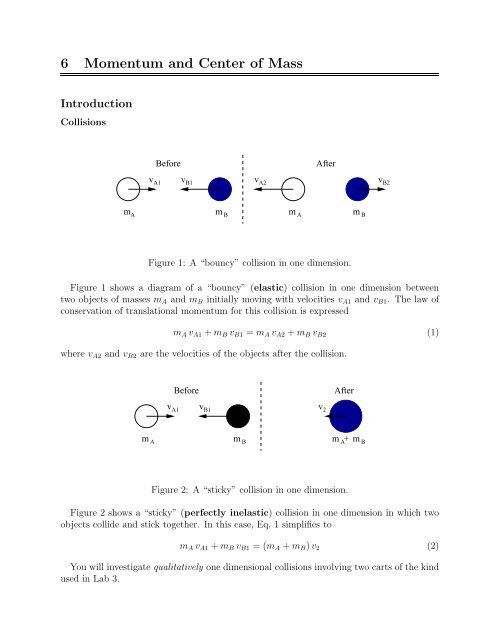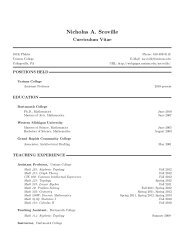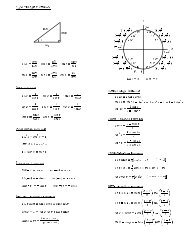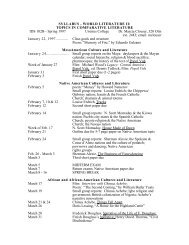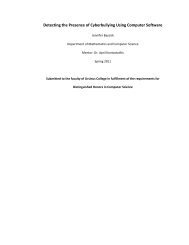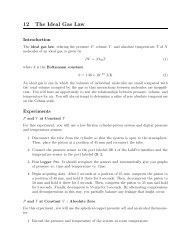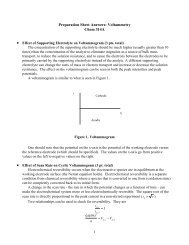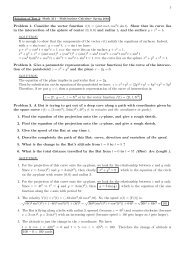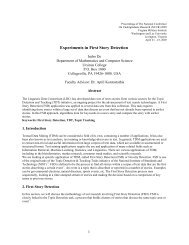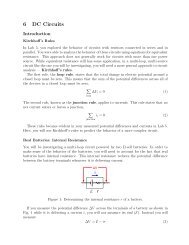Lab 6 : Momentum and Center of Mass
Lab 6 : Momentum and Center of Mass
Lab 6 : Momentum and Center of Mass
You also want an ePaper? Increase the reach of your titles
YUMPU automatically turns print PDFs into web optimized ePapers that Google loves.
6 <strong>Momentum</strong> <strong>and</strong> <strong>Center</strong> <strong>of</strong> <strong>Mass</strong>IntroductionCollisionsBeforeAftervA1vA2vB2m ABv B1m mm ABFigure 1: A “bouncy” collision in one dimension.Figure 1 shows a diagram <strong>of</strong> a “bouncy” (elastic) collision in one dimension betweentwo objects <strong>of</strong> masses m A <strong>and</strong> m B initially moving with velocities v A1 <strong>and</strong> v B1 . The law <strong>of</strong>conservation <strong>of</strong> translational momentum for this collision is expressedm A v A1 +m B v B1 = m A v A2 +m B v B2 (1)where v A2 <strong>and</strong> v B2 are the velocities <strong>of</strong> the objects after the collision.Beforev B1 v 2Afterv A1m A m A+m Bm BFigure 2: A “sticky” collision in one dimension.Figure 2 shows a “sticky” (perfectly inelastic) collision in one dimension in which twoobjects collide <strong>and</strong> stick together. In this case, Eq. 1 simplifies tom A v A1 +m B v B1 = (m A +m B )v 2 (2)You will investigate qualitatively one dimensional collisions involving two carts <strong>of</strong> the kindused in <strong>Lab</strong> 3.
<strong>Center</strong> <strong>of</strong> <strong>Mass</strong>The center <strong>of</strong> mass <strong>of</strong> a system <strong>of</strong> particles is given by⃗R com = 1M sys(m A ⃗r A +m B ⃗r B +m C ⃗r C +...) (3)where⃗r A ,⃗r B , ⃗r C , ... are the positions <strong>of</strong> all <strong>of</strong> the particles in the system. In two dimensions,Eq. 3 corresponds toX com =Y com =1(m A x A +m B x B +m C x C +...)M sys1(m A y A +m B y B +m C y C +...) (4)M sysEqs. 3 <strong>and</strong> 4 also work for systems <strong>of</strong> extended objects, where the labels A, B, C, ...refer to objects instead <strong>of</strong> particles, <strong>and</strong> the positions ⃗r A , ⃗r B , ⃗r C , ... are the positions <strong>of</strong> thecenters <strong>of</strong> masses <strong>of</strong> the objects. Here, you will be considering two systems <strong>of</strong> objects – amobile <strong>and</strong> a person walking on a cart with “frictionless” wheels. In both <strong>of</strong> these cases, youcan ignore the vertical component <strong>of</strong> equation 4.ExperimentsCollisions in One Dimension1. Investigate “sticky” <strong>and</strong> “bouncy” collisions with carts <strong>of</strong> equal mass (no additionalmass added).(a) Under what circumstances is one <strong>of</strong> the objects stationary after the collision?(b) Under what circumstances are both <strong>of</strong> the objects stationary after the collision?2. Repeat the above process with carts <strong>of</strong> unequal mass. (Add both masses to the cart.)Mobile ConstructionConstruct a mobile following the general design shown in Figure 3 from two meter sticks,three mass hangers carrying 50 g, 100 g, <strong>and</strong> 200 g, <strong>and</strong> several lengths <strong>of</strong> string. Usethe concept <strong>of</strong> center <strong>of</strong> mass to explain quantitatively the locations <strong>of</strong> the pivot points <strong>of</strong>the meter sticks in your completed mobile. Show your mobile to your instructor/TA beforemoving on to your next task.Walking the PlankAn 8 foot plank is mounted on two carts in the middle <strong>of</strong> the lab. Explain what you observewhen one <strong>of</strong> the members <strong>of</strong> your lab group walks at a brisk pace from one end <strong>of</strong> the plankto the other. Please be careful – a spotter on either side <strong>of</strong> the plank should keep pace withthe walker just in case.
QuestionsFigure 3: Mobile design. (Locations <strong>of</strong> your pivot points may vary.)1. (a) Under what circumstances in one dimensional collisions between two objects is one<strong>of</strong> the objects stationary after the collision? (b) How about both objects? (c) How doyour answers change if the objects have different masses?2. Where were the pivot points <strong>of</strong> the meter sticks in your mobile? Give your reasoning.3. What happens when a person walks the plank-on-wheels? Explain.


